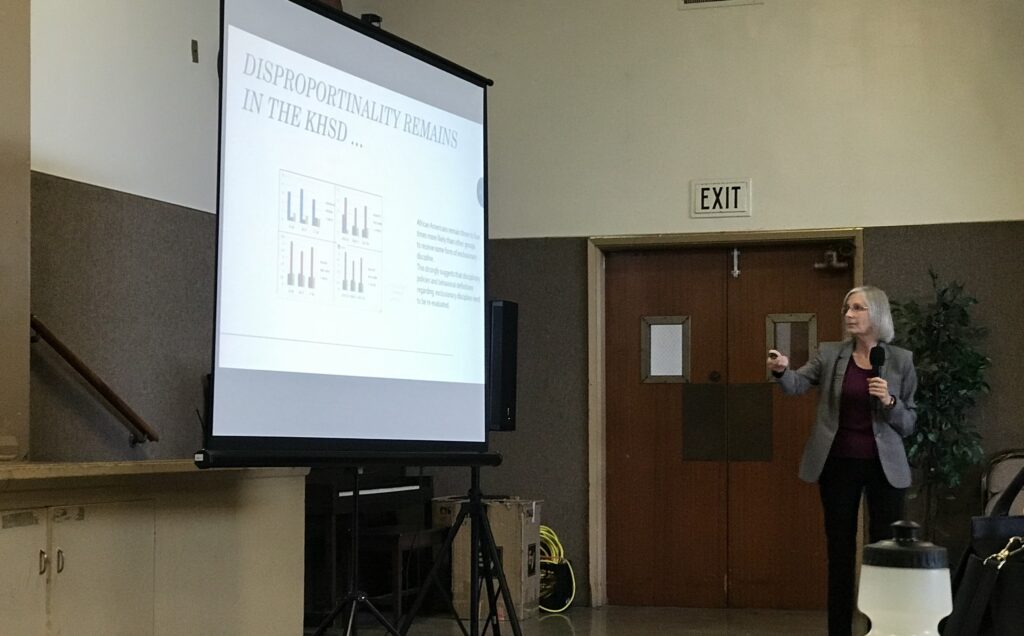
Although suspensions and expulsions have decreased over the years at the Kern High School District, advocates remain concerned the district is still finding ways to push out students of color.
The Kern Education Justice Collaborative, a local organization that fights for education equity in Kern, said at a community forum Wednesday evening the number of voluntary and involuntary transfers have continued to rise over the years, and advocates link those numbers to a rise in expulsions at continuation schools.
“Even as expulsions are going down, the number of children exiting from general population is not necessarily going down,” said Cynthia Rice, director of litigation for the California Rural Legal Assistance.
Members of KEJC went over data weeks before the district’s fifth legally mandated community forum, which is part of the terms of a $670,000 settlement agreement the district entered into in 2017 after more than 20 plaintiffs – CRLA being one – accused KHSD of disproportionately suspending and expelling Latino and African American students.
Rice, along with other members of KEJC, believe the district is using voluntary and involuntary transfers as a way to push out students of color.
“An alternative to expulsions is voluntary transfers,” Rice said. “What happens is a child is suspended then recommended for expulsion and offered a voluntary transfer as an option. Students accept it to keep their record clean.”
According to data provided by KEJC, Latinos account for the majority of both voluntary and involuntary transfers, which Rice said isn’t surprising since the district’s population is majority Latino.
However, the probability rate of African American students being voluntarily transferred out of general education is three times more likely than white students.

Cynthia Rice, director of litigation for the California Rural Legal Assistance, presents on suspension and expulsion rates at a community forum Wednesday.
“That disprotionality should not exist if this is a voluntary decision,” Rice said.
African American students make up just 5.8 percent of KHSD’s sudent population, but they account for 18.5 percent of voluntary transfers and 10.7 percent of involuntary transfers.
As the number of transfers within the district has increased, so has the number of students enrolling in KHSD continuation schools. All five continuation schools in the district saw an increase in students from the 2016-17 school year to 2017-18.
“What does that mean,” asked Nadine Banuelos, legal research assistance for CRLA. “They are still finding ways to push kids out of schools and using a different way.”
Data shows the suspension and expulsion rates at all five continuation schools have increased. Central Valley High, one of KHSD’s continuation schools, saw a 13 percent increase in suspension and expulsions from 2017 to 2018.
“Where do you go when you get expelled from these schools,” asked Banuelos. “Continuation schools are the first step to the school-to-prison pipeline.”
KEJC members believe there are steps that can be taken to address the disproportionate rates within KHSD.
Members are calling on the district to retain a diverse staff that is reflective of the student population. Studies show students perform better when they have teachers they can relate to.
KHSD agreed to recruit and hire a diverse staff, and in the Local Control Accountability Formula, the district promised to retain a staff reflective of the student body.
To help address this promise, KHSD has started a teaching residency program with CSU Bakersfield and Educators Rising clubs on high school campuses for students aspiring to be teachers.
However, those efforts don’t seem to have made in impact on the staff, yet. Nearly 66 percent of the student population is Latino, while nearly 66 percent of the teaching staff is white.
It remains unclear why the district has not met its goal in hiring a diverse staff.
“Research show educators of color is one of the most effective ways of addressing this unequal treatment,” said Yoana Tchoukleva, a member of the Equal Justice Society. “We live in a society where black students are stereotyped. It’s important to have teachers that don’t believe in those biases.”
African American students are four times more likely to be suspended in the KHSD and three times more likely to be expelled.
Tchoukleva pointed out this isn’t just a problem in the KHSD; it’s a problem across the country.
“This is a product of systemic racism and the history of this country,” she said.
The district will address this data at the next community forum, set for Sept. 24. The Community Forum will be held at 7 p.m. in DeMello Hall at West High School, 1200 New Stine Road.